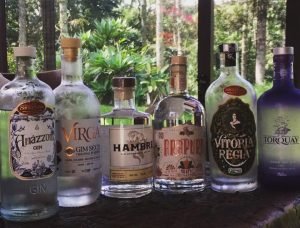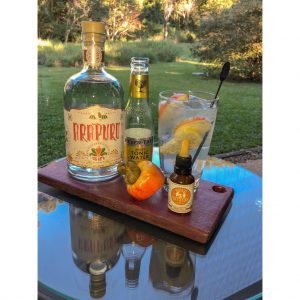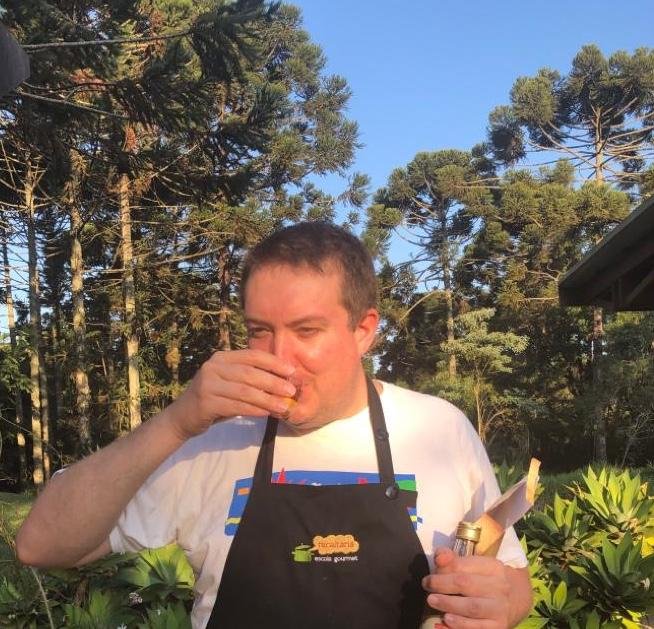I have always loved Gin
I grew up in the South of England in a time when Aunt Ethel and Dot Cotton sipped their G&T from wine glasses in the Queen Vic, and Gordon’s and Beefeater were the only brands that people really knew. At home, my brothers and I would pick sloes from the hedgerows for our parents to make the yearly Sloe Gin, that we helped ‘prick the sloes’ for and bottle. As a teenager taking part in a student exchange program in Jerez, in the South of Spain, I was introduced to Cubalibres, with Larios Gin & Coke, and there was no turning back for me.
I plan to be writing a series of articles about the growing Gin scene here in Brazil where I have lived for over a decade. As well as a Gin Lover, I am also an amateur distiller and studying with the IBD (Institute of Brewing & Distilling) with the ultimate aim of qualifying as a Master Distiller. I hope to give a view not only on Gins in Brazil but also the trials and tribulations of opening my own Distillery & Gin School, in the countryside to the South West of Sao Paulo.
Brazil

Brazil has more to offer then meets the eye when it comes to gin
When I first started to visit Brazil in the 1990s, Gin here was limited to a few well know imports, and Seagers Gin produced locally. I since learned, that there were actually about 5 Nationally-produced Gins (Bols, Bosford, Burnett’s, Gilbey’s & Seagers). Almost no one here drank Gin, or even really knew of Gin. Tonic water is sold alongside other soft drinks, and commonly drunk as a drink on its own, like Coke or Sprite, rather than viewed as a mixer.
The National drink in Brazil is a sugar cane rum called Cachaça (ka-sha-sa), with which the Caipirinha cocktail is made – a potent mix of rum, sugar and limes. Cachaça is distilled in thousands of ‘Alambiques’ across the country. From large-scale commercial distilleries to small, back-yard productions – almost all using copper stills, not unlike those used for Gin production. Apart from Beer, Whisky was the go-to drink of the young and old – from bars and clubs, to Weddings and Christenings. Cachaça, while now starting to get some recognition as a National Treasure, has mostly been viewed as a slightly down-market drink, fit only for the beach or casual BBQ gathering. Whisky was expensive, classic, imported and aspirational.
Things are starting to change
However, all that is starting to change. As a new generation of drinkers come of (legal) age they are starting to choose gin as their tipple of choice. Whisky is starting to become the drink of ‘Vo-vo’ (Granddad), and Gin is the new, fun & exciting drink of the moment. By 2019, the Gin market here has grown to 75 or more Brazilian Gins, with most launching in 2017 onwards, and nearly half of all of these Gins coming from the state of Sao Paulo, where I live. Similarly, the market for imported Gin has also exploded. Whereas 20 years ago, there were 4 imported Gins in Brazil (Tanqueray, Bombay Sapphire, Gordon’s and Beefeater) there are now around 70, the majority of which are from the UK.
Despite this new-found interest in Gins, both home-grown and imported, the Market shows little sign of fatigue yet. Brazil has not yet started to talk about ‘Peak-Gin’ or suffer from ‘Gin-Fatigue’, and it is still common to meet people who may have only tried Gin once or twice in their lives. A lot of the innovation and variation seen in the UK Market has not yet arrived here, so I am expecting many more years of growth still.
So – what is different about Gin in Brazil
Two things spring to mind –
- The culture of Distilling that stems from Cachaça production
- The range of tropical fruits, seeds and barks available to Distillers in Brazil
The huge variety of botanicals here is also exciting, with ingredients that we don’t even have names for in English, and even ingredients that are relatively unknown outside of the area in Brazil they come from. I hope to share more details of some of these ingredients, and the work some Distillers have done to track them down and try them, in future posts.
One possible explanation for the rapid growth in National Gins here is how quickly the Distilleries were able to switch production to Gin, with Gin being a drink that is actually re-distilled alcohol in most cases, with added flavours. Here lies one of the issues – Brazilian legislation on Gin simply requires that it be a spirit of between 35% to 54% ABV, (more on that later) with Juniper and other flavourings, natural or artificial, added during the re-distillation process. As a result, many of the Brazilian Gins on the market today are made in a process more similar to the distillation of the ethanol used to run cars here, than a small-batch, craft or artisanal process to create good quality, well flavoured Gin. This is reflected in the pricing, with a large proportion of the products selling for between R$ 18 – R$30 (between £3.50 to £6.00 for a 750ml bottle). It’s not quite Hogarth’s “Drunk for a penny, dead drunk for twopence”, but not far short!

Arapuru Gin created in partnership with Master Distillers like Rob Dorsett, of Martin Millers fame,
All is not lost
Brazil is producing excellent Gins, winning International awards, and expanding into the European Markets. They might even appear on a supermarket shelf near you – more on this to come. Expertise has been bought in, with Master Distillers like Rob Dorsett, of Martin Millers fame, partnering with a local Distillery to create Arapuru Gin, Brazil’s first London Dry Gin, as well as Entrepreneurs qualifying as Master Distillers, like Arthur Flosi from BEG Gin, who won the Gold Award in the Spirits Selection at the Concours Mondial de Bruxelles, in 2018. Then there are the new-comers to the industry like me, starting out slowly, and studying to become a Master Distiller, while trying to create a unique and worthy Gin, here in Brazil. I look forward to sharing some of my experiences with you here on Theginblog.
Follow us on Facebook and Instagram and check out the Gin Forum on Facebook!
If you want us to review your gin or you fancy writing for the Gin Blog then contact us now


A most interesting Blog, especially for a Gin man such as myself.
Well done!
PS:- I miss Sloe Gin a great deal, and like yourself, used to collect sloes, prick them with a needle and put them in a bottle topped up with gin for a year or more before enjoying. I can’t find any here in Brazil….any clues?
Best wishes…Alastair